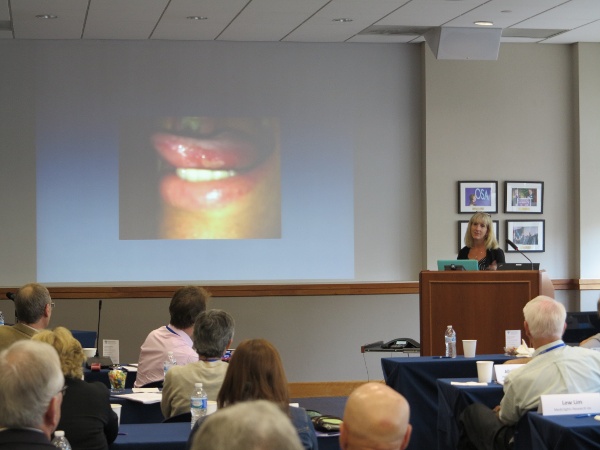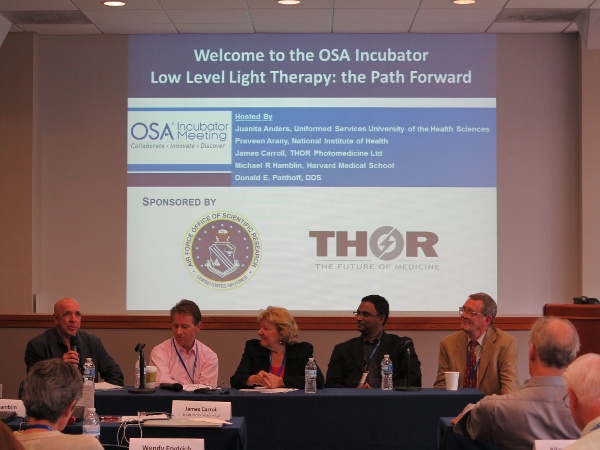Low Level Light Therapy: What Comes Next
Low Level Light Therapy: What Comes Next
Elieza Tang
Roberta Chow, Quantum Pain Management, kicked off the day with “Clinical Use of Low Level Light Therapy: A Focus on Pain”. In the U.S., the total incremental cost of healthcare due to pain ranges from $261BB to $300BB (Gaskin, D.J. and Richard, P.R. 2011, Relieving Pain in America: A Blueprint for Transforming Prevention, Care, Education, Research). Currently, the common clinical treatment for pain management is opioids, analgesics and NSAIDs (non-steroid anti-inflammatory drugs). However, there are serious issues with long-term use of these pharmaceutical drugs, so LLLT stands as an attractive alternative treatment option for pain management due to its noninvasive nature and low risk of side effects.
Roberta asked if there is a lack of guidelines, regulatory approval and industry standards, is it possible that LLLT could be too good be true? Despite more than 400 randomized controlled trials and 4,000 laboratory studies on the positive effects of LLLT, it has yet to be adopted by mainstream medicine.
Margaret Naeser, VA Boston Healthcare System, answered that question by discussing research on Transcranial LED (light emitting diode) to Improve Cognition in Chronic Tramatic Brain Injury (TBI). Each year 1.7 million patients are evaluated for traumatic brain injury. The participants in the studies she discussed who had transcranial LED treatment had improved working memory, an increased ability to work on the computer, and many had reduced depression scores.
Nathaniel Treister, Brigham and Women's Hospital, talk explored why LLLT/PBM is not a routine treatment for oral mucositis (inflammation of the oral mucosa manifesting as erythema and ulcerations). He directly addressed the limitations of LLLT into mainstream medicine. The vision he presented focuses on several factors: the need for multi-center randomized controlled trials, higher impact publications and creating a gold standard guideline for LLLT treatment approved by societies such as American Society for Blood and Bone Marrow Transplant as well as the demand for proper marketing to enable safe device use.
Oral mucositis is a serious problem and in an oncology nursing survey, 97% of nurses rated oral mucositis as a significant problem. Annette Quinn, University of Pittsburgh, discussed her work in the treatment of oral mucositis with LLLT/PBM. She demonstrated exciting improvement of oral mucositis cases, which were treated with LLLT. Annette’s laser treated patients have better pain control, with reduced need of opioids, decreased need for percutaneous endoscopic gastrostomy, and has enhanced patient quality of life.
To delve further into patient care and treatment, discussion turns to industry, with a lively discussion with Clark Tedford, LumiThera, Inc. and Allan Gardiner, PhotoMed Technologies, Inc. The focus is to develop a consensus on professional commitments for a new collaborative initiative in health care. The agreement amongst the participants is that Allan’s presentation on “sensor-based evidence” is a great way to provide care for patients directly, show them the efficacy during LLLT treatment, and it is an objective way to access the efficacy of the clinical therapy.
The Incubator concluded with a lively discussion around the following questions:
1. Where do we want to go with LLLT/PBM?
2. What do we need to do to meet that goal?
It was concluded that what is needed are:
- More rigid guidelines
- Standardized protocols; consistent parameters
- Appropriate regulation on laser devices
- Proper training
- Publish in higher impact journals, which are read by healthcare professionals
- Applications of LLLT are broad, which leads to skepticism of its efficacy
- Defined industry responsibility; ex. false promises, deceptive marketing
- Clearly defined return on investment
- Address the lack of insurance reimbursement
This Incubator has been a great experience for me to participate in. I have enjoyed witnessing collaborations between so many different disciplines and learning more about LLLT/PBM. This OSA Incubator was an innovative way of bridging the gap between basic science researchers, clinicians, and representatives from industry. These experts are committed to working towards bringing LLLT to the forefront as an efficacious noninvasive treatment modality in the clinical setting. LLLT is an area of focus that requires an interdisciplinary approach combining science, medicine, and technology in an effort to improve patient health. In the next few years, I will be on the lookout for more medical breakthroughs in LLLT.

Oral mucositis after low-light treatment.

Panelists lead the closing discussion.
